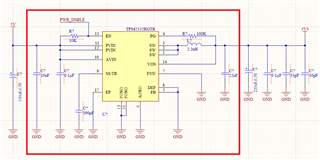Other Parts Discussed in Thread: TPS62086, TPS62903, TPS61232
Hi,
I designed a step down converter for the 4G module. A regulator like the TPS62086 would have been easier, but I had to choose the TPS62132 because it was not in stock. The red area was the design proposed by Webenc Power designer. I put in other capacities as they suggest in their 4g module schematics (tantalum or other seramic capacitors)

Max input 5.5V,
- Do I have problems with issues such as ripple voltage at 3.3V output or voltage values of tantalum capacities?
- Are there any other issues I should pay attention to in the diagram?
- Apart from that, are there any issues that I need to pay attention to while drawing the layout?
Best regards,
Mehmet

